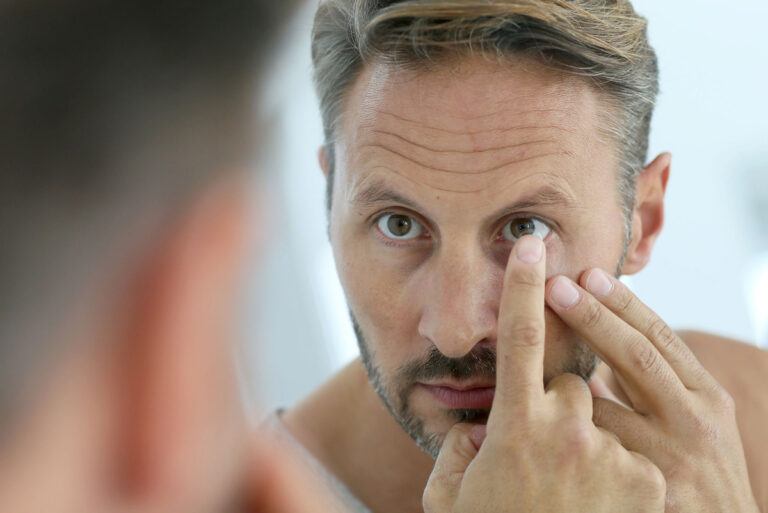The tear film of the human eye is extremely important to the vision process. It lubricates the eye surface and keeps it smooth. The tear film consists of two parts. The first part is the aqueous (mostly water) component, produced by the lacrimal gland (below the eyebrow). The aqueous component of the tears flow along the lower edge of the eyelid into the tears and then into the nose.
If water were the only component of the tear film, the film would immediately evaporate as soon as the eye is opened – leaving the surface of the eye unprotected. However, there is more to the tear film. Below the aqueous portion of the tear film lies a mucus layer and above the water lied a thin oily film produced by the meibomian glands of the eyelids, which reduces the rate at which the aqueous layer evaporates. It’s only this oily layer that makes it possible to keep the eyes open for a long time without the tear film breaking open.
Blepharitis happens when the tiny oil glands in your eyelids (called meibomian glands) get blocked—often due to long-term inflammation. These glands normally add oil to your tears to keep them from drying out too quickly. When they’re blocked, your tears evaporate faster, leaving your eyes feeling dry and irritated.
As the tears evaporate, they also cool the surface of your eye. Your eye can detect this small drop in temperature and sends a signal to make more tears. That’s why, strangely enough, people with dry eyes can sometimes have very watery eyes—your body is trying to fix the dryness by producing more tears.
In early stages, “plugs” appear on the edge of the eyelid which block the openings of the sebaceous glands. In this case, a simple mechanical cleaning can be effective.
However, if the inflammation of the eyelid margin is not treated for years, the eyelid will change anatomically. The edge of the eyelid becomes increasingly rounded and is no longer able to distribute the tear film on the surface of the eye, similar to a windscreen wiper with gaps on the windshield.
In addition, systemic diseases such as psoriasis (rosacea), diabetes, polyarthritis, lupus erythematosus and Sjögren syndrome can cause dry eye. Hormonal changes (such as those caused by hormone replacement therapy during menopause and contraceptive pills) are also a potential cause of dry eye syndrome. Other chronic inflammatory diseases like Crohn’s disease and ulcerative colitis can lead to a dry eye, because of the strong diarrhea and nutrient malabsorption.
Dry eye is not an immediate danger to vision, but it can make everyday life uncomfortable. It often affects your quality of life in a big way.
The symptoms can be mild or severe, and may include burning, stinging, blurry vision, double vision, and headaches. Many parts of modern life—like using a computer, watching TV, or reading from a phone, tablet, or book for a long time—can make these symptoms worse.
One of the most common reasons for people to visit an ophthalmologist is for dry eye treatment. Many professionals sit in front of computer screens for most of their working day. Most office spaces have air conditioning. Screen use decreases your rate at which you blink; air conditioning dehydrates you. Either circumstance can cause dry eyes; but the combination really increases the chances of you having “Dry Eye Syndrome” (DES). Sometimes it’s called “Computer Vision Syndrome”, “Office Eye”, or is just described as “tired eyes”.
Contact lens wearers often develop DES after a few years of wearing the lenses (especially soft contact lenses), and shift workers and night workers commonly develop DES, as tear film production (the natural lubricant of the eye) is affected by circadian (day/night) rhythms – at night, less tear film is produced. Finally, tear film production decreases as people age, to the point that a significant proportion of people aged 65 years or older have DES (although people of all ages can be affected).
The good news is that your dry eyes can be treated – and there’s more that can be done that just offering lubricating eyedrops.
In Switzerland, up to 600,000 people may suffer from various degrees of dry eye. But the real number is probably even higher, because many people have symptoms but haven’t seen a doctor yet.


Dry eyes generally affect people of all ages, with an accumulation of the following populations:
Get in touch
During office hours.
Email us.
Make an appointment, and come to see us.
Thank you for writing a review on google.
Contact us here, we will get in touch with you.
Zoom online consultation for our international patients.
Contact us here, we will get in touch with you.
Contact us here, we will get in touch with you.
Stay informed & get the newsletter
You have successfully joined our subscriber list.
Newsletter abonnieren & informiert bleiben
Sie haben sich erfolgreich in unsere Abonnentenliste eingetragen.
Bitte bestätigen Sie Ihr Abonnement, indem Sie auf den Link in der E-Mail klicken, die wir Ihnen gerade geschickt haben.